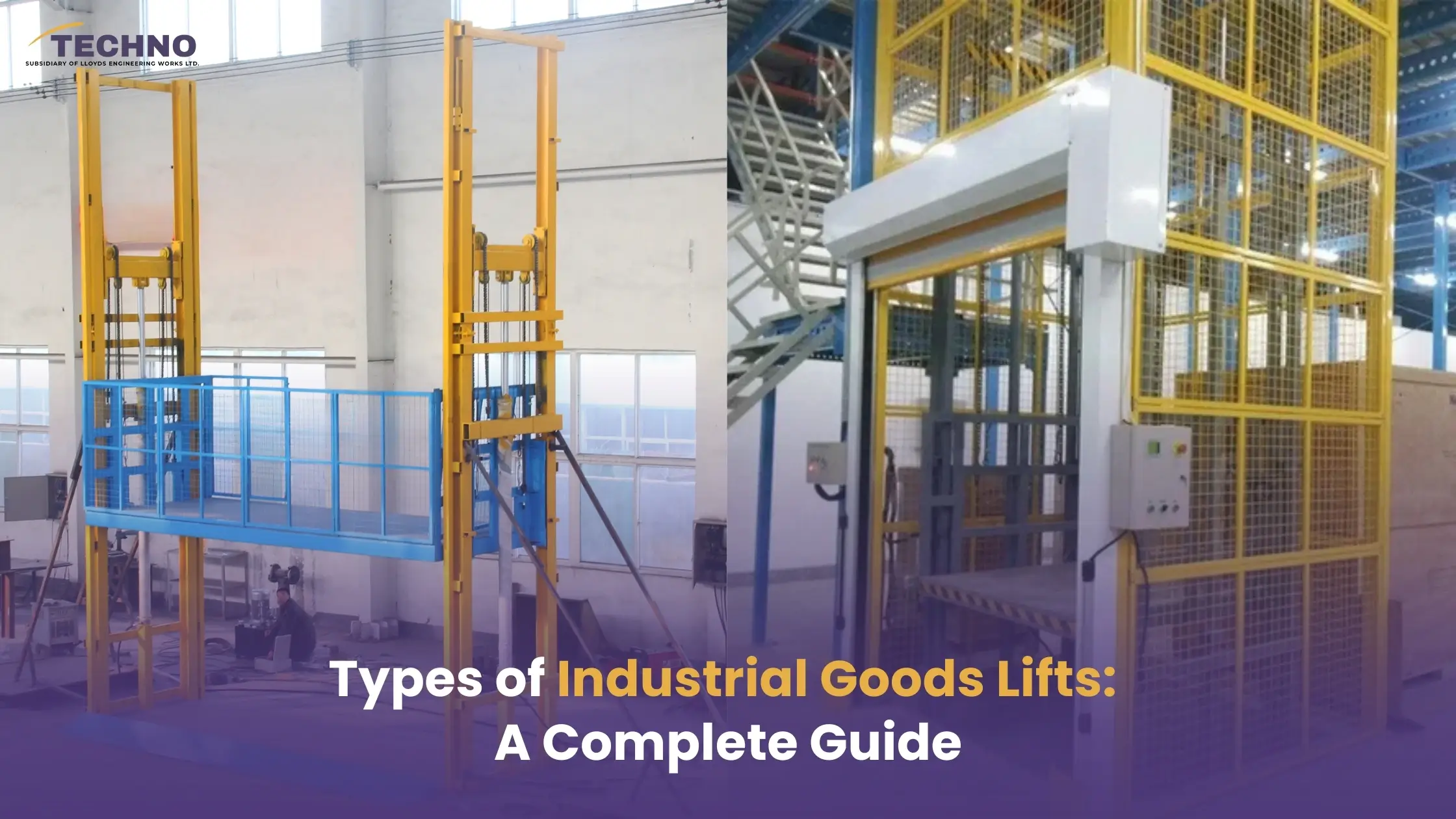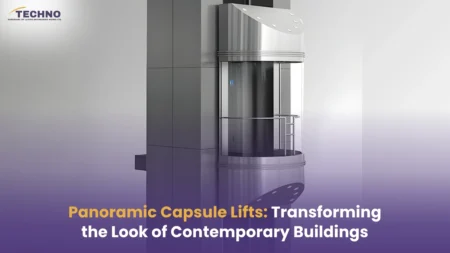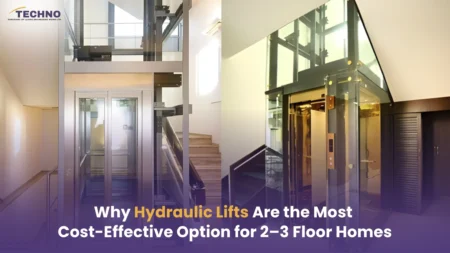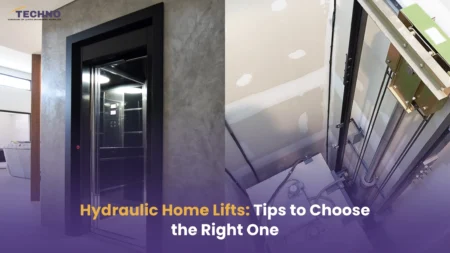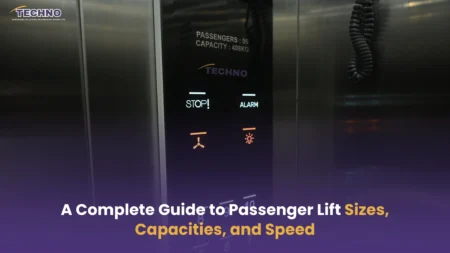You never need a lift until you really need such emergency work. Industrial spaces have a way of doing that. Everything is functioning until it isn’t.
You’re standing in a warehouse. Pallets stacked to the ceiling. Forklifts humming. Workers skirting around each other in a quiet ballet of efficiency and willful disorder. But one obstinate crate — heavy, unwieldy and crucial — requires passage up three floors. Now.
And then it dawns on you: a real goods lift for industry is not a luxury. It is the beating heart of the workflow. So, let’s help you get the clarity needed to find the perfect one. Consider this your goods lift guide for industry. No fluff. No jargon. Just smart decisions.
What Are Industrial Goods Lifts?
“Essentially, an industrial goods lift is precisely what its name suggests: a piece of equipment designed to transport materials vertically. No passengers. No frills. Just strength, safety, and reliability. Picture it as an industrial elevator, just flintier, more focused.
Whether it’s a platform lift for goods, a cargo lift in a logistics center, or a commercial goods lift behind the scenes of a retail loading dock, they all have one thing to do: move heavy stuff safely.
An industrial goods lift, a mechanical device used to move materials up and down inside a building. Unlike passenger elevators, these lifts are constructed solely for the movement of goods — whether it be heavy machinery, raw materials, or packed consignments. Safe, convenient, and time-saving alternative to working with heavy loads that would otherwise require manual labor or on a Forklift.
Simply put, a goods lift is the lifeline of shifting merchandise in any industrial system. It guarantees smooth operations and lower operational costs, while also improving production efficiency through more efficient vertical logistics. Whether you require a hydraulic goods lift, cargo lift, or platform lift for goods, each variety serves the same basic function — to transfer heavy loads safely through industrial and commercial settings.
Why Should You Care?
An industrial goods lift is designed to do only one thing well: move materials up with accuracy and with power. Consider it the muscle powering your operations. No matter if your operation is a warehouse full of stuff stacked up to the ceiling or some kind of manufacturing facility humming with heavy machinery, these lifts are literal tools for taking over the backbreaking part of going up and down between levels. Whether taking raw materials to the ground floor or finished products up for dispatch, an installed lift system ensures more space, speed, and security.
But here’s why you should care — because every little second makes a difference in industrial settings. There’s only so much that can be lifted by hand or on forklifts. Each delay in getting goods moved is a killer to productivity. Each loaded trip puts employees at risk of injury or products at risk of damage. Goods lifts remove such bottlenecks. They make life easier on you, save your humans some strain, and allow your people to focus on what’s really important — production and performance.
And there is a layer to it. A quality installed goods lift is not only a piece of equipment – it’s an investment in the ongoing safety and economic scalability of your business. The bigger your business, the more you need. You don’t need to reconfigure your warehouse or factory layout, if you have the right goods lift; your site grows with you.
Key Benefits of Using Industrial Goods Lifts in Warehouses and Factories
Efficiency. Safety. Time. Money. That is what a properly fitted warehouse goods lift provides.
Now you can take the guesswork out of hand operation. You reduce workplace injuries. You speed up throughput. A single lift can save hours of morning work. And when you’re dealing with high volume, that’s not just useful, it’s survival.
Better productivity — A goods lift helps to quickly move pallets, crates or machinery up and down vertically, resulting in reduced travel time between floors.
More efficient vertical space usage – Warehouses have the option of using mezzanines or upper levels, not limited to ground floor storage.
Manual handling risks are minimised — It’s never good news if a worker has to shift heavy weights upstairs manually, as there’s a chance they’ll have an accident and injure themselves; lifting equipment remedies that problem, making it safer for those who use it.
Enhanced workflow and productivity — Reliability in conveying vertically keeps material moving on the go and to your line at prescribed rates.
Long-term cost savings — While there’s an upfront investment, less labour hours, fewer downtimes and less damaged product add up to a better ROI.
Increase the safety of your goods and staff — Our high-capacity lifts feature overload protection, interlocks and smooth operation to safeguard both inventory and staff.
Flexibility and adaptability – You can customise goods lifts to your loading equipment size, layout, floor-to-floor distances in warehouses or factories.
Types of Goods Lifts Based on Operation (Hydraulic, Traction, Electric, Pneumatic)
Here’s where it gets interesting. There are several ways to lift a 700 kg box. Let’s break it down:
Traction goods lifts
Working principle: An electric hoisting machine rotates a sheave to lift wire ropes or belts connected to the car and a counterweight; braking and variable‑speed drives govern motion and stops accurately.
Variants: Geared and gearless traction; gearless is standard for greater performance, and geared may be suitable for moderate loads and speeds; MRL (machine‑room‑less) designs position compact machines at the shaft top to minimize space.
Electric goods lifts (rope/belt with motor control)
Working principle: General category of electrically powered hoists operating ropes/belts and drives for smooth up/down motion without hydraulic fluid; tends to overlap traction in operation but sold separately in goods‑only solutions and smaller freight packaging.
Advantages: High-speed options, stable motion control, and reduced fluid‑associated maintenance; adjustable capacity and duty cycle to complement continuous retail or freight operations.
Pneumatic goods lifts:
Operating principle: Differential air pressure in a set of cylinders or a vertical tube powers the car/payload, employing vacuum/pressurized air to lift and lower oilless; pressure control valves are used for positioning.
Advantages: Clean operation free from hydraulic fluids, possible application in cleanrooms/pharma, and easier maintenance near contamination‑sensitive areas; certain designs are capable of operating under minimal electrical infrastructure with compressed air.
Each system has its place. This is not about what would be best overall. It is a question of what you want for yourself.
Classification by Application: Warehouse Lifts, Factory Lifts, and Cargo Lifts
Not all lifts live the same life. Others grind away at dust and grease in factories. Others slink through the slick backrooms of retail.
Industrial lifts don’t live the same life. A lift that thrives in a dusty warehouse might struggle on a precision-driven factory floor. A cargo lift built for freight hubs might be overkill for smaller operations.
Choosing the right one isn’t just about specs — it’s about context. Here’s how each type earns its place in the industrial ecosystem:
Warehouse Lifts: The Backbone of Material Flow
In a warehouse, time is money — and movement is everything. Pallets, cartons, tools, and raw materials need to move up and down all day, every day. That’s where warehouse goods lifts prove their worth.
Built for high-frequency operation, these lifts are designed to handle the chaos: multiple loading cycles, constant start-stops, and varying weights. They feature reinforced platforms, smooth hydraulic or traction systems, and wide entry access for forklifts and trolleys.
Factory Lifts: Precision in Motion
Factories are a world of coordination. Machines hum in sequence, production lines depend on timing, and safety isn’t optional — it’s sacred.
Factory goods lifts are built to respect that rhythm.
These lifts are often custom-engineered — tailored to your load dimensions, travel height, and operational environment. Enclosed cabins, interlocked gates, and anti-vibration systems make them safe, steady, and compliant with the strictest industrial norms.
Cargo Lifts: The Heavy-Duty Powerhouses
When the loads are massive and the schedule relentless, cargo lifts take over. These are the heavyweights — built for logistics centers, shipping yards, and large-scale storage facilities.
Equipped with high-capacity platforms, reinforced steel frames, and industrial-grade drive systems, cargo lifts can haul tons of freight across multiple levels without breaking a sweat. They’re made for endurance — long hours, continuous cycles, and minimal downtime.
Load Capacity and Size Variations in Industrial Goods Lifts
From small access material handling lifts in buildings to large heavy duty goods lift in factories, the size and load range are immense.
Category | Capacity (kg) | Typical platform (mm) | Typical install/shaft (mm) | Use case |
Dumbwaiter | 50–300 | 450×450 to 1000×1000 | 800×800 to 1300×1300 | Service items, hospitals, hotels |
Small goods | 300–500 | 900×900 to 1200×1200 | 1300×1300 to 1500×1500 | Retail, small warehouse |
Hydraulic goods (std) | 500–2500 | 1000×1000 to 2000×2500 | 1300×1300 to 2000×2500 | General warehouse/factory |
Medium goods | 1000–2500 | 1400×1700 to 2000×2500 | 2250×2100 to 3350×3050 | Manufacturing/logistics |
Heavy duty | 3000–5000 | 2000×2800 to 2400×3600 | 3350×3250 to 4050×4150 | Heavy industrial |
Extra heavy | 8000–10000 | 3000×4000 to 3500×4500 | 4700×4600 to 5000×5000+ | Mining/shipyards |
Freight (A–C3) | 900–9070+ | 1800×2400 to 4500×6000+ | 2400×2800 to 5500×7000+ | General for forklift/heavy loads |
Mezzanine/VRC | 1000–10000 | 1000×1000 to 3000×3000 | Freestanding | Multi-level warehouses |
Scissor table | 300–8000 | 815×500 to 6000×2000 | Ground/pit mount | Docks/workshops |
A low-capacity industrial goods lift might handle 300 kg. A large one? Try 3,000+ kg. Choose wrong and you have bottlenecks — or something breaks.
Safety Features Every Industrial Goods Lift Should Have
This isn’t optional. You’re lifting literal tons.
A good lift should include:
- Emergency stop buttons
- Overload sensors
- Interlocked gates
- Non-slip platforms
- Manual lowering functions
And, most of all, following safety regulations. The following are key factors to consider when it comes to finding the right goods lift door installation solutions, and any reputable goods lift manufacturers in Ahmedabad, such as Techno Elevators, should be able to help you answer all those questions with a resounding yes.
Energy Efficiency and Maintenance Requirements of Goods Lifts
Energy efficiency and maintenance requirements vary extremely with goods lift type and duty profile; traction/electric systems tend to be most efficient for mid‑ to high‑rise, while hydraulics are best suited to low‑rise heavy loads but consume more power on ascent runs, and pneumatic units sacrifice efficiency for cleanliness of operation and oil‑free design.
Planning must marry realistic duty-cycle estimates to a preventive maintenance scheme sized to capacity, number of floors, and control sophistication to optimize downtime and lifecycle cost.
Downtime and lifecycle cost
Downtime effect: In operational warehouses/factories, every hour of lift out of order can have ₹5,000–₹15,000 in productivity cost through wasted labor, delayed picking, and recovery overtime — resulting in preventive maintenance being a high-ROI investment.
Lifecycle comparison: In more than 15 years, traction systems usually achieve 15–25% less operating cost compared to similar hydraulics in mid‑rise conditions due to reduced energy and reduced fluid-related maintenance, while hydraulics still hold the upper hand for low‑rise heavy‑duty with less complex mechanics and reduced initial capex.
Cost Factors: How to Budget for Industrial Goods Lift Installation
Industrial goods lift installation budgeting involves elaborate planning beyond the cost sticker, including equipment, civil work, regulatory, concealed costs, and operating costs for the long term.
Findings in current Indian market data indicate total costs of projects ranging from ₹9–26.5 lakhs based on capacity, travel height, and project site complexity, with year-round running costs contributing ₹45,000–1.2 lakhs.
Strategic budgeting should include shaft construction, permits, GST, maintenance contracts, energy consumption, and modernization cycles to minimize cost overrun and generate maximum return on investment in the form of productivity improvement and low workplace injuries.
Equipment purchase accounts for 40–60% of the overall project cost and differs substantially depending on operation type and capacity. Hydraulic goods lifts are the majority among Indian industrial uses: simple machines (300–500 kg, 12 ft) are priced at ₹1.8–3.5 lakhs, typical models (1–2 ton, 2–4 floors) go from ₹4–5.8 lakhs, and heavy-duty machines (2–5 tons, 5+ floors) are priced at ₹7–12 lakhs.
Electric/traction lifts provide greater speed and efficiency at ₹5.4–8 lakhs for 1–2 ton capacity covering 3–6 floors, whereas MRL systems require ₹8–15 lakhs for 1–3 ton capacity covering 4–8 floors because of space-efficient engineering. Pneumatic lifts are appropriate for cleanrooms at ₹6–10 lakhs for 0.5–1 ton capacity covering 2–4 floors.
Type | Capacity | Floors | Equipment (₹) | Installed (₹) | Annual Opex (₹) | Notes |
Hydraulic (basic) | 300–500 kg | G+1 | 1.8–3.5 L | 5–9 L | 0.2–0.35 L | Light duty, quickest install. |
Hydraulic (standard) | 1–2 T | G+2–G+4 | 4–5.8 L | 8–12 L | 0.35–0.55 L | Warehousing workhorse. |
Hydraulic (heavy) | 2–5 T | G+3–G+6 | 7–12 L | 14–20 L | 0.4–0.7 L | High load, slower speed. |
Electric/Traction | 1–2 T | G+3–G+6 | 5.4–8 L | 9–15 L | 0.3–0.45 L | Faster, energy‑efficient. |
MRL (freight) | 1–3 T | G+4–G+8 | 8–15 L | 13–23 L | 0.35–0.65 L | No machine room; premium. |
Pneumatic | 0.5–1 T | G+2–G+4 | 6–10 L | 8–13 L | 0.35–0.5 L | Clean environments, niche. |
Latest Technological Innovations in Industrial Goods Lifts
Industrial goods lift have undergone a revolution in their sophistication.
Features and Benefits of the Next Gen Industrial Lifting Devices
IoT-Enabled Monitoring
Your lift should not only move materials — it should do so smartly. With IoT-based monitoring, every run is live-tracked. Before your troubles even begin, with live performance data, predictive alerts and system health notifications.
Remote Diagnostics
No more waiting for a technician to “come take a look.” And remote diagnostics allow the ability to access your system so experts can troubleshoot it quickly–reducing downtime and saving maintenance costs.
Touchscreen Control Panels
Forget the old metal switches. New touchscreen-based control panels bring all these features and more with an easy-to-use, user-friendly interface. Simple to train, simple to operate and easy to mold precisely under pressure.
Energy Regenerative Drives
Each lift generates energy — why throw it away? Our regenerative drive systems harvest that power and pump it back into the grid. The upshot: lower energy bills, a higher efficiency rating and a lighter carbon footprint.
Now, even commercial goods lifts are becoming smarter to reduce downtime (they can sense if repairs are needed), adjust for load fluctuation and let you know before a breakdown is due to occur.
If your lift doesn’t talk data, you may already be losing.
Choosing the Right Goods Lift: Factors to Consider for Your Industry
Investing in the appropriate goods lift is an important choice for any industrial location. The right lift will be the one that meets your operational needs, is capable of efficiently lifting the load you need to carry and enables any materials to be transported safely without interruption.
There are a few things that you must consider before you go on to install it.
First, let’s work out how much load you are going to need for your operation. A warehouse that deals with laden pallets or machinery is likely to prefer a heavy-duty goods lift capable of lifting 2000 kg or more, while smaller workshops can do just fine with lifts between 500 and 1000 kg.
The platform size and lift dimensions should be the next thing to consider. It should be big enough for your largest load unit – whether it’s crates, drums, or packaged product – with comfortable working space to load and unload safely.
Think about the drive that would be suitable for your space. Hydraulic platform elevators are suitable for smooth and mild speed operations and use very little space. Traction or electric lifts work well for high-rise buildings with a lot of cycles. Scissor lifts make a practical solution for ground-level or between-floor-level transfers.
Final Thought
Your lift is not a machine in a box. It’s a choice that shifts your entire business.
So, if you are thinking ahead — if you’re doing smart building — don’t wing it. Do the work. Ask around. Discover reliable Goods Lift Manufacturers in Ahmedabad, like Techno Elevators, who are experts and talk to humans.
And even if you’re not sure where to start?
Just reach out. It could be the best decision you make all year.
For good operational excellence, an Industrial Goods Lift is a necessity in high-level industrial environments. When it comes to operating a warehouse, …

